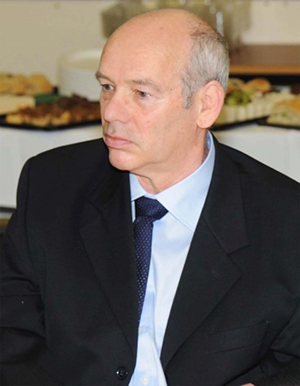About the University of Leicester
Nick Standen
 Noel Davies and Ian Forsythe write:
Noel Davies and Ian Forsythe write:
Nick Standen, Professor of Physiology at the University of Leicester, died after a long illness on 2 April 2020 (born 8 December 1949). He’d read Natural Sciences at the University of Cambridge and did his PhD in electrophysiology under the supervision of Bob Meech, also at Cambridge (1971-74). He was initially appointed as Lecturer in Nottingham, but soon moved to the then Department of Physiology at the University of Leicester in 1976; he rose to Reader and then a Personal Chair in 1996; Nick remained at Leicester until ill health forced his retirement in 2010.
Nick’s research interests focused on the biophysical properties and physiological regulation of ion channels. During his PhD, he discovered calcium-activated potassium currents and this was published in The Journal of Physiology with Bob Meech. At Leicester Nick formed a long-standing collaboration and close friendship with Peter Stanfield; this led to several important papers on both calcium and potassium channels in muscle and nerve and culminated in the formation of the Ion Channel Group.
Later, Nick’s research interests evolved toward arterial smooth muscle, cemented by another close collaboration with Mark Nelson at the University of Vermont. These studies included the first report of ATP-dependent potassium channels in smooth muscle and were supported by many prestigious research grants. Of his many scientific accolades we remember three: he was Chair of the Editorial Board for The Journal of Physiology (1991-94), elected to Fellowship of the Academy of Medical Sciences in 2001, and made Honorary Member of the Physiological Society in 2010.
No-one could collaborate with Nick without becoming a friend. His relaxed manner and remarkable intellect earned respect from colleagues and students alike, and this was sustained by a keen work ethic. He was incredibly loyal and supportive to his research staff, fighting for funding to maintain their posts. Undergraduate students appreciated his enthusiastic teaching, and he was very much on the students’ side in ensuring they received the best training, as he was particularly skilled at explaining difficult concepts.
Nick loved to be outdoors, especially in mountainous areas where he would go rock climbing, hill walking, and later deer stalking. This enthusiasm for climbing generated some interesting methods for painting the house eaves, which was certainly inconsistent with health and safety! His contribution to physiological science is well recorded in his extensive research publications – but those that worked with him will remember his humour in everyday living and the joy in their joint enterprise of physiological discovery.
Nick leaves behind his wife Alison, son Jonathan and twin daughters Claire and Jessica and their families.